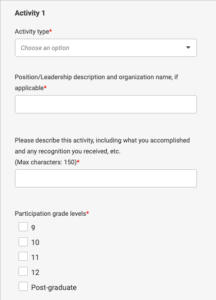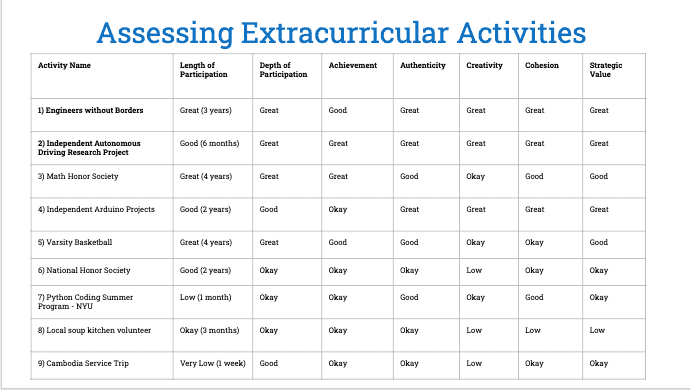
What makes an extracurricular activity "good"?
You’ve heard it before: Colleges care about your extracurricular activities! But what makes an extracurricular activity “good”? Believe it or not, the answer to this question is relatively formulaic, at least where college admissions are concerned. In this article, we will tackle the criteria that colleges want to see when examining your extracurricular activities.

By NOELLE COMPTON
Disclaimer: At first glance, this article appears to be only for high school seniors, but do not be deceived! Although we will discuss extracurricular activities through the lens of the Common App, this information is arguably most important for younger students who have the time and power to adjust their trajectory.
When it’s time to apply to colleges, the majority of students will use the Common Application to do so. On the Common Application, students are asked to both explain their extracurricular activities and to rank them. Although this exercise seems basic, it is very important that this task is completed correctly, as your admissions decisions can depend on it. So if this matters so much, then how should students approach this task? What makes an extracurricular activity good enough to include, and how should I rank these activities?
Extracurricular Activities on the Common Application
In the past, students were invited to fill out up to twenty extracurricular activities on the Common App, and as a result, hilarity and chaos ensued. Students would stretch any little activity to sound like an extracurricular (e.g. “Once facilitated the safe and timely transmission of an elderly woman across a high-traffic intersection). The Common App has since limited their list to only ten activities hoping to see legitimate, high quality engagement. This definitely does demonstrate an appreciation for the depth of involvement rather than the breadth of activities in which one is involved. However, we do recommend that you try to get as close to ten activities as you can.
When an admissions officer looks at your extracurricular activities, this is what they see:


To summarize, we see the following:
- Type of activity
- Position/leadership description + Name of Organization
- Description (150 characters)
- Participation grade levels
- Timing of participation
- Hours spent per week
- Weeks spent per year
- Intention to continue activity in college
Evaluating extracurricular activities
Aside from these fields, students are also asked to rank their activities from one to ten in order of value.
Based on these criteria, we can surmise what makes an extracurricular activity “good” so far as the admissions officer is concerned. Please note that this is not a reflection on the intrinsic value of an activity. There are plenty of activities that make you feel good and help the community but still, for whatever reason, lack admissions value. This article is not about those activities. Rather, this is meant to be used as a practical guide for choosing which activities to include on your college application, not to participate in for a fruitful, happy life.
That said, here are the items that you should consider when filling in the extracurricular activity portion of the Common App. In other words, this is what makes an extracurricular activity “good”:
- Length of participation
- Depth of participation
- Achievement
- Authenticity
- Creativity
- Strategic value
- Cohesion
Please note that these criteria are meant to be considered as part of an overall strategy, and that there isn’t necessarily a hierarchy here. Our hope is that once you have read the explanations, a clear order will emerge in your activities.
Length of Participation
The longer you have participated in an activity, the better. Four years is better than one year. To the admissions officer, length indicates commitment, and commitment is a valuable metric. Longevity helps to support a compelling interest in a given activity. Even though your one or two week camp might have been an incredibly meaningful experience for you, I would not necessarily place this experience first on your list. One caveat to note is that of current involvement. For example, if you did debate team for three years but did not participate during your senior year, then this is not a good activity to put first. However, if you participated during 9th, 11th, and 12th grades, then it is okay to consider.
Depth of Participation
The more time you devote to an activity each week, the better. Five hours a week is better than thirty minutes a week. Demonstrating dedication to an activity indicates believable support for a student’s interest. Similarly, a five week camp of forty hours per week is considered to have a strong depth of participation, even though it isn’t especially long in terms of weeks per year. But when it comes to depth of participation, don’t neglect your ROI. If you are committing many hours per week to an activity with little opportunity to earn awards, rankings, or leadership positions, then I would reconsider this activity in favor of one that allows you to amass achievements. Which brings me to the next point…
Achievement
Positions of leadership are more valuable than general positions, and so is being the founder of a club or initiative. Awards and rankings are great ways to demonstrate achievement in an activity as well. Having tangible results in your “description” section are particularly useful. Think of your application as a resume and consider the deliverables you can put forth. Raising $20,000 for your cause is an impressive achievement, which comes with good admissions value.
College Admissions Services
Schedule a Free Consultation
Meet with a mentor one-on-one via video chat to talk about your son/daughter’s admissions plan. Afterwards, receive a no-obligation Customized College Roadmap (CCR) with advice on courses, extracurricular activities, standardized tests, and Admissions Angle strategy.
Authenticity
When we are talking about authenticity, there are two points to consider: First, did you really engage in an activity? By now, we are all familiar with the college admissions scandals of yesteryear. As a result, admissions officers now receive training for how to detect phony accomplishments. It is never a good idea to lie on your application, so don’t.
But the second aspect of authenticity is whether or not you engaged in an activity out of genuine interest or whether you are trying to “win points” with the admissions officers. I like to recall the episode of Gilmore Girls where the cold and ambitious Paris Gellar lists her “charitable” deeds (from Habitat for Humanity to “adopting dolphins”) as a way to compel the Harvard admissions office. These transparent attempts to curry favor for being a good person are not generally that impressive to admissions officers, but more than that, consider the timing. Signing up for five clubs, two sports, and three service activities at the start of senior year doesn’t exactly radiate authenticity. For this reason, doing so will not play well on your application.

Creativity
Admissions officers have, by now, seen every activity under the sun. Therefore, if you have a creative spin or have come up with something original, they will be really excited. This is especially true now that coronavirus has limited students’ abilities to engage with their old activities normally. How did you take the opportunity of quarantine to adjust your activities or find new ways to get involved? For ideas on how to do this, I would suggest reading our blog on extracurricular activities you can do from home. In any case, though, a creative activity can score you a lot of points where extracurriculars are concerned.
Strategic value
If you don’t know by now, our strategy for admissions is called an Admissions Angle. An Admissions Angle says that each part of your college application should contribute to a clear “story of you” and that this should connect to your chosen path of study or intended major. If you are applying to business school, then some of your activities should relate to business. Ditto art, ditto computer science, ditto pre-med. Consider how your extracurricular activities support your entrance into this field, and put the most pertinent items earlier on your list.
Cohesion
As I mentioned, your application is going to tell the “story of you.” How do your extracurricular activities work together? How do they connect to your letters of recommendation and your essays? Certainly, your activities should support your area of study, but think about how to supplement your major-related activities. Are you a mathlete who is also an athlete? Are you a programmer by day competitive break dancer by night? Is your art inspired by your love of chemistry? There is no one activity that necessarily defines your application, but the intersection of your interests and accomplishments can help you stand out. When thinking about cohesion, remember to take a step back. Consider your application as a whole and think about whether it tells a complete story.
A sample activity ranking
Below, we have outlined the academic performance of a sample student, Robbie. Robbie’s chosen Admissions Angle is mechanical engineering and his list of extracurricular activities looks like this:

Now, based on these activities, we have assessed the value of the metrics we discussed and assigned the order that we would recommend for the Common App:

What makes an extracurricular activity "good"?
Almost all extracurricular activities are good in their own way, regardless of whether they play well at the admissions office. It is our advice to do the things that make you happy, contribute positively to your community, and work hard to beautify the lives of people around you. That said, when it comes to the Common App, the above factors are helpful in selecting which activities to include and in which order they should appear











